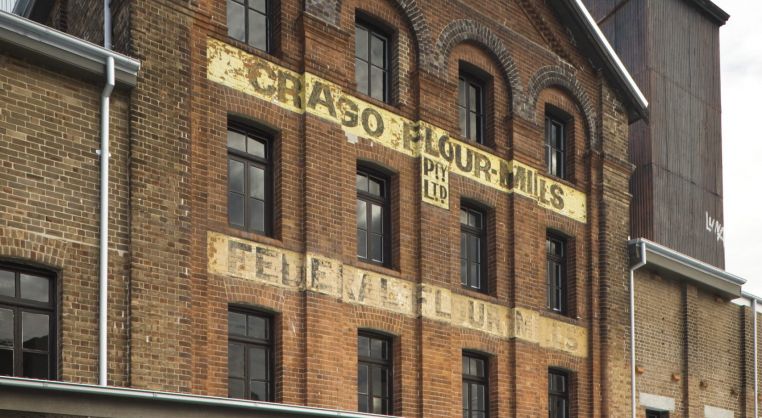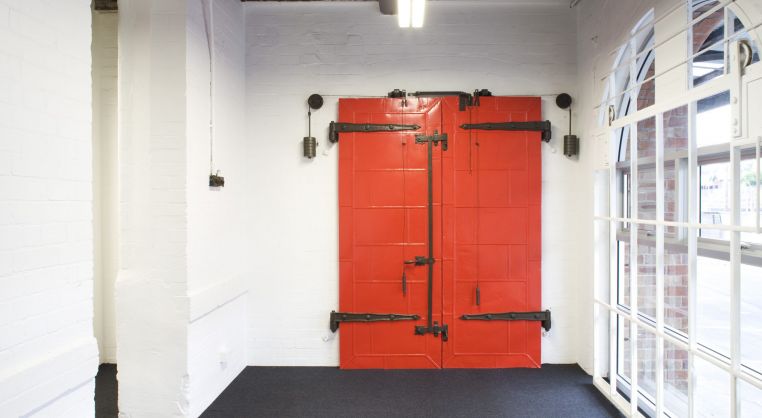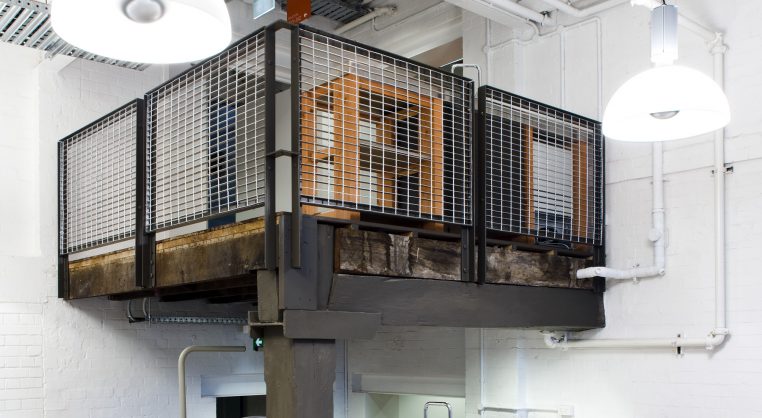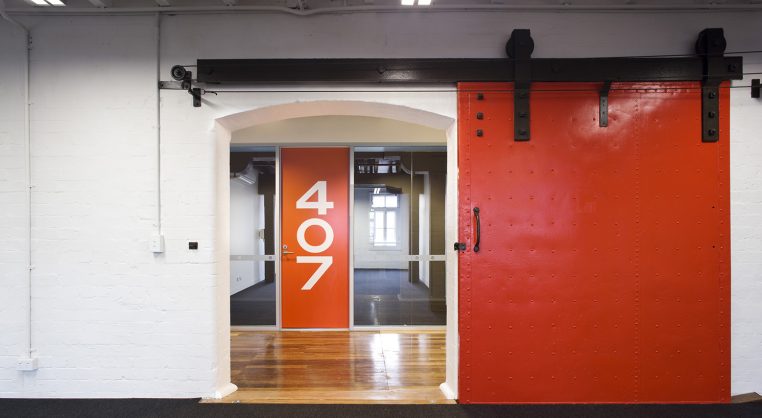Flourmill Studios is a commercial development of 47 strata studios, with shared spaces and a cafe, housed in the nineteenth-century Crago Flour Mill in Newtown, Sydney. The flour mill is adjacent to the railway line and close to the station in an area with a substantial industrial history.
The development provides affordable studio spaces for small creative businesses. The adaptive reuse seeks to amplify the building’s industrial qualities, using the flour mill’s structure, fabric and remnant industrial artefacts to give the project a specific character, while maintaining the existing overall plan structure and volumes. The robust industrial aesthetic also informs the new architectural, landscape and graphic work, which is designed to read as a new layer in the life of the building.
Download a printable version of the Flourmill Studios case study (PDF 546 KB).
Site history and heritage
Crago Flour Mill operated from 1897 until 1984 and was added to and altered as milling technologies changed. When the mill closed much of the machinery was removed, but the main pulley shaft, some hoppers and wheel drives and a goods lift remained. From 1984 the building was used for storage, a dance school and studios for artists and craftspeople. When the developer purchased the mill, it was a run-down warren of spaces over four buildings, with little access from one part to another, and no clear entrance. It did not comply with the Building Code of Australia in many areas, particularly in terms of fire egress and safety.
Crago Flour Mill is listed on the local heritage inventory by Marrickville Council.
Opportunities
The flour mill – with its structure of thick timber columns and beams, steel trusses and remnant machinery – had the potential to become an engaging workplace attractive to the target market – small creative businesses, who responded to the raw industrial aesthetic and inner urban location.
Challenges
The principal challenge was to make the ‘rabbit warren’ of four buildings – with different structures, floor levels and circulation – work as a coherent complex with appropriate access and fire egress.
Care was also needed to ensure that the addition of the lift tower did not adversely affect the roofscape.
There were public concerns about the changes of use and the potential loss a creative facility. This was ameliorated in part through the new use also providing upgraded small-scale facilities for creative industries.
Approach and outcome
The project sought to retain as much heritage fabric as possible, including substantial scars that evoked previous alterations. The planning aimed to keep the mill plan legible within the reuse, while rationalising circulation.
The large, new entry courtyard, and street -level cafe contribute to the streetscape and urban environment. The new circulation route starts with a street-front entry leading to a central core containing lift, stair and amenities and the east-west circulation spine, which connects the various parts and levels. This rationalised system involved making openings at each level and creating internal hallways.
The adaptive reuse retains the hardwood, concrete and steel structure; the timber loading-bay; and metal-clad fire doors (now painted bright red). Remnant machinery, including large hoppers, drive shafts, wheels and belts remain within studio spaces and the three-storey pulley shaft, located in the main circulation spine, is enclosed with fixed fire-rated glass panels.
Non-significant accretions were removed. This exposed the original form of the building, created views in and out, and increased natural light levels inside. Internal partitions were removed, returning spaces to original volumes.
The interior is subdivided into studios in a manner that respects the areas and volumes of the original spaces. The aim was to create flexible, adaptable interiors that would help extend the life of the building, while allowing the original plan to be easily read within the adapted building.
New work is distinguished by modern materials, bold graphics and bright colours. This continues the robust industrial aesthetic, while also reading clearly as new.
Interpretation was integrated from the beginning of the project and the new work is designed to be reversible. Limited car parking is supplemented by a bike parking/locker facility and a Go Get car parking space.
The design team worked closely with the BCA consultant and fire engineer and the resulting innovative solutions to compliance issues allowed the design ideas to be realised. The architecture, landscape and graphic teams also worked closely together to realise the design ideas.
Lessons
- Reuse as small, strata-title offices made sense in terms of the inner city location and meant that the logic of the original plan of could be kept.
- Building fabric and remnant industrial machinery were retained. This became a selling point for the desired market of small-scale creative businesses.
- Interpretation was designed as an integral aspect of the project.
- Close collaboration between consultants resulted in a coherent aesthetic and allowed non-standard solutions to BCA compliance (egress and fire), which supported the architectural and heritage approach.
Project team
Architect and graphic designer: Allen Jack + Cottier Architects. Developer: Podcorp Holdings. Planner: City Plan Services. Conservation Management Plan: City Plan Heritage. Quantity surveyor: Built Holdings. Builder: Built Holdings. Structural engineer: Woolacotts Consulting Engineers. Services engineers: Timar Partnership. Landscape architects: 360 Degrees. Access consultant: Accessibility Solutions. Heritage consultants: City Plan Heritage. BCA consultant and fire engineer: Stephen Grubits and Associates. Certifier: Advance Building Approvals. Building surveyor: Denny Linker & Co.






